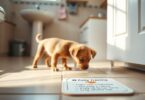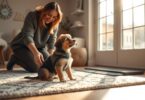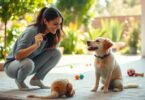Bringing home a new puppy is an exciting journey, but it comes with its challenges. Have you ever wondered how early training can shape your puppy's behavior and strengthen your relationship? Starting early is crucial for building a strong bond and preventing future issues.
Positive reinforcement is a powerful method where treats and praise encourage good behavior. This approach not only makes training enjoyable but also sets the stage for advanced techniques. Real-life examples from reputable programs highlight the effectiveness of these methods.
This guide covers basic commands and expert-backed strategies, ensuring you're well-equipped to manage interactions with your puppy. With consistent, reward-based methods, you'll learn how to create a positive environment that fosters growth and understanding.
Getting Started with Puppy Training
Welcoming a new puppy into your family is an exciting moment, but it requires careful preparation. Ensuring your home is puppy-proof and equipped with the right supplies is essential for a smooth start. This preparation not only keeps your puppy safe but also sets the stage for effective behavior management.
Preparing Your Home for a New Puppy
Puppy-proofing your home is crucial to prevent accidents and ensure your puppy's safety. Secure loose wires, toxic substances, and fragile items out of reach. Creating a safe environment helps in managing your puppy's behavior from the very beginning.
Essential Supplies and Puppy-Proofing Tips
Investing in the right supplies is vital. A crate is indispensable for training and providing a safe space. Choose durable toys that can withstand chewing. Training tools like clickers or leashes are also necessary. Experts recommend selecting high-quality supplies that align with your puppy's needs and your training goals.
Setting up separate areas for play, rest, and training helps establish boundaries and consistency. This structured environment reduces distractions and saves time in the long run. By creating clear zones, you help your puppy understand where each activity takes place.
Effective Dog Training Tips for Puppies
Creating a structured routine at home is key to successful puppy training. Experts recommend starting with simple commands like “sit,” which lays the groundwork for more complex behaviors. A consistent routine helps your puppy feel secure and understand expectations.
Using high-value rewards is essential for motivating your puppy. Choose treats your puppy loves to make training sessions enjoyable and effective. Consistent rewards help your puppy associate the action with the desired behavior.
Teaching “sit” begins with a treat. Hold it above your puppy's head and move it backward. As they follow the treat with their nose, they'll naturally sit. Reward and praise when they do. Repeat this process until they learn the command.
Clear cues and consistent rewards are vital. Use a specific hand signal and the command “sit” each time. Consistency helps your puppy understand what's expected, making learning faster and more effective.
Expert advice suggests short, engaging sessions. Keep training fun and positive to maintain your puppy's interest. With patience and consistency, your puppy will master basic commands and develop good behavior.
Establishing Basic Obedience with Your Puppy
Teaching your puppy basic obedience commands is essential for their development and your peace of mind. These foundational skills help with socialization and create a strong bond between you and your puppy. Positive reinforcement is key to making learning enjoyable and effective.
Teaching “Sit” and “Stay” Commands
Start with the “sit” command. Hold a treat above your puppy's head and move it backward. As they follow with their nose, they'll naturally sit. Reward with praise and the treat. Repeat this process until they learn the command.
Once “sit” is mastered, introduce “stay.” Have your puppy sit, take a few steps back, and say “stay.” Gradually increase the distance and time. Positive reinforcement will help them understand this command.
Introducing the “Come” Cue Effectively
The “come” command is vital for safety. Start in a quiet area with few distractions. Call your puppy by their name and say “come,” using a happy tone. Reward them with treats and praise when they respond.
Practice in different locations and situations to reinforce the command. Consistency and positive reinforcement will make your puppy reliable in responding to “come.”
Basic obedience commands like “sit,” “stay,” and “come” provide structure and support socialization. They help your puppy navigate the world confidently and set the stage for advanced training.
Housebreaking and Potty Training Strategies
Housebreaking is one of the most critical aspects of raising a well-behaved puppy. Establishing clear routines and using positive reinforcement can make this process smoother for both you and your puppy.
Creating a Consistent Potty Schedule
A consistent schedule is key to successful housebreaking. Take your puppy outside immediately after meals, naps, and playtime. As a general rule, puppies can hold their bladder for hours equal to their age in months. For example, a 4-month-old puppy can typically wait up to 4 hours.
Experts recommend taking young puppies out every 1-2 hours. This frequency helps prevent accidents and teaches your puppy to go potty outside consistently. Over time, you can gradually increase the time between breaks as your puppy matures.
Using Positive Reinforcement for Success
Positive reinforcement is a powerful tool in potty training. Whenever your puppy goes potty outside, reward them with treats, praise, or playtime. This positive association encourages good behavior and speeds up the learning process.
Recognizing your puppy’s signals is also important. If they start sniffing or circling, it’s likely they need to go. Quickly taking them to the designated potty area can prevent accidents. Consistency and patience are vital during this phase.
Crate Training for a Calm Environment
Crate training is a valuable tool for creating a secure and calm environment for your puppy. By introducing the crate gradually, you can help your puppy see it as a safe space, reducing anxiety and aiding in housebreaking.
Introducing the Crate as a Safe Space
Start by placing the crate in a common area, like the living room, with the door open. Encourage your puppy to explore it by placing treats or toys inside. This positive introduction helps your puppy associate the crate with good experiences.
Once your puppy is comfortable entering the crate, begin closing the door during meals or playtime. Start with short periods, such as 10 minutes, and gradually increase the duration. This gradual approach helps your puppy adapt without feeling isolated.
Consistent use of the crate can improve your puppy's behavior by providing a sense of security. It also helps with potty training, as puppies are less likely to soil their sleeping area. However, remember not to leave your puppy in the crate for extended periods, as they need time outside for play and bathroom breaks.
Patience is key during crate training. Ignore whining unless it indicates distress, as negative reinforcement can create bad habits. Over time, with consistent use and positive reinforcement, your puppy will view the crate as a calm and safe place.
Reward-Based Training and Positive Reinforcement
Reward-based training is a cornerstone of effective puppy training and potty training. This method focuses on encouraging desired behaviors through treats, praise, and other positive outcomes. By associating good actions with rewards, you create a strong foundation for learning and behavior development.
Selecting High-Value Rewards
Choosing the right rewards is essential for motivating your puppy. High-value treats, such as small pieces of cooked chicken or cheese, are often more effective than lower-value options. Toys or playtime can also serve as rewards, especially for puppies that are highly toy-motivated.
It’s important to tailor your rewards to your puppy’s preferences. Some puppies may respond better to treats, while others prefer praise or play. Offering a variety of rewards keeps training sessions engaging and prevents boredom.
Timing Your Praise and Treats for Maximum Impact
The timing of your rewards plays a crucial role in training success. Treats and praise should be given immediately after the desired behavior to create a clear association. For example, the moment your puppy sits on command, offer a treat and say “good sit.”
Consistency is key. Use a specific marker, like a clicker or a whistle, to signal the exact moment your puppy performs the correct action. This precision helps your puppy understand which behavior earned the reward.
As your puppy becomes more proficient, you can phase out the rewards. Start by only rewarding the best performances, then gradually introduce play or life rewards, like going for a walk, as a way to celebrate success.
Reward-based training not only accelerates learning but also strengthens the bond between you and your puppy. By focusing on positive reinforcement, you create a supportive environment that fosters confidence and good behavior.
Socializing Your New Puppy for a Confident Future
Socialization is a cornerstone of raising a confident and well-adjusted puppy. It’s about introducing your puppy to new people, animals, and environments to help them navigate the world with ease. This critical period, typically between 3 weeks and 16 weeks of age, shapes their future behavior and temperament.
Gradual Exposure to New People and Animals
Start by exposing your puppy to familiar people and animals in a controlled environment. Gradually introduce new faces, ensuring each interaction is positive. For example, invite friends over or visit quiet parks where your puppy can meet other dogs one-on-one. Always make sure these interactions are safe and supervised.
Building Positive Experiences Through Play
Play is an excellent way to reinforce social skills. Use toys or treats to encourage positive interactions. When introducing your puppy to new people or animals, use a specific cue like “meet” to signal it’s a positive experience. This helps your puppy associate new encounters with good outcomes.
Remember, every interaction is a learning opportunity. By integrating socialization with other forms of training, such as crate training, you create a well-rounded and confident companion. With patience and consistency, your puppy will grow into a friendly and adaptable adult dog.
Advanced Techniques: Lure, Capture, and Shaping Methods
Once your puppy has mastered basic commands, it's time to explore advanced techniques that refine their skills and deepen your connection. Lure, capture, and shaping methods offer effective ways to teach complex behaviors, enhancing your puppy's learning experience.
Mastering Lure Training for New Behaviors
Lure training is a popular method where treats guide your puppy into desired actions. For instance, use a treat to lure your puppy into a “spin” by moving it in a circle above their head. This technique is excellent for teaching tricks and commands, keeping sessions engaging and fun.
Remember to phase out lures gradually. Start by using them sparingly, then switch to praise or play. This helps your puppy focus on the command rather than just the treat.
Effective Use of Markers and Capturing Strategies
Capturing involves rewarding your puppy for naturally occurring behaviors. For example, when they sit without prompting, immediately reward them. This method encourages spontaneous actions, making training feel more natural.
Shaping takes capturing further by building complex behaviors step-by-step. Reward small progressions, like lifting a paw, until your puppy learns the complete action. Consistent, positive reinforcement is key to successful shaping.
Using markers like a clicker helps pinpoint exact behaviors, ensuring your puppy understands which action earned the reward. This precision enhances learning and strengthens your bond.
Managing Common Training Challenges
As you guide your new puppy through the learning process, you'll inevitably encounter challenges. Distractions, overexcitement, and unwanted behaviors like biting are common hurdles. Addressing these issues requires a patient approach and a clear schedule to ensure effective outcomes.
Handling Distractions and Overexcitement
One of the biggest challenges is managing distractions, especially in dynamic environments. Start by identifying triggers and gradually expose your puppy to these stimuli in a controlled manner. For instance, begin training in a quiet area and slowly introduce more distractions over time. A consistent training process will help your puppy focus and respond reliably, even when distractions are present.
Overexcitement can also hinder progress. To calm your puppy, incorporate short breaks and use calming signals like a gentle touch or a familiar command. This helps re-establish focus and maintains a positive learning environment.
Addressing Unwanted Behaviors Like Biting
Unwanted behaviors, such as biting, often stem from teething or overstimulation. Redirect your puppy's attention to appropriate chew toys and use positive reinforcement to encourage desired actions. For example, when your puppy bites, calmly say “no” and offer a suitable alternative. Consistent responses help your puppy understand what behaviors are acceptable.
Establishing a weekly schedule is crucial for monitoring progress and adjusting your strategies as needed. Allocate specific times each week to address different challenges, ensuring a structured approach to training. This schedule not only helps in tracking improvements but also in identifying areas that may require more attention.
Recognizing when a method isn't working is essential. If you notice minimal progress despite consistent efforts, it may be time to adjust your approach. Consider integrating different techniques or seeking guidance from a professional trainer. Remember, every puppy is unique, and what works for one may not work for another.
If challenges persist, don't hesitate to seek professional help. A trainer can offer personalized strategies tailored to your puppy's specific needs. Their expertise can provide valuable insights and help overcome stubborn issues, ensuring your training process remains effective and stress-free.
Lastly, maintain a calm and consistent approach. This helps re-establish positive behavior patterns and strengthens the bond between you and your puppy. With patience and the right strategies, you can navigate common training challenges and guide your new puppy toward a well-behaved future.
Parting Insights for a Lifelong Bond with Your Puppy
As you continue your journey with your new companion, remember that every minute spent on consistent routines and positive reinforcement strengthens your bond. Experts emphasize that ongoing engagement and patience are key to fostering a lifelong connection with your puppy.
Creating a secure house environment and sticking to potty schedules are foundational for successful housebreaking. By dedicating just a few minutes each day to these routines, you set your puppy up for long-term success and a well-adjusted demeanor.
Use the techniques discussed throughout this guide to build a nurturing relationship. Whether it's through short training sessions or positive reinforcement, every small effort contributes to your puppy's development. For personalized guidance, consider reaching out to professional trainers who can offer tailored advice to enhance your journey.
By combining patience, consistency, and care, you'll create a disciplined yet loving home. This approach not only aids in house training but also fosters a confident and well-behaved companion. Embrace each minute as an opportunity to nurture and guide your puppy toward a happy and healthy life.











Leave a Comment